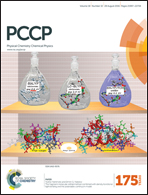Spectroscopic properties and location of the Tb3+ and Eu3+ energy levels in Y2O2S under high hydrostatic pressure
Abstract
In this contribution, an extensive spectroscopic study of Y2O2S doped with Eu3+ and Tb3+ is presented. Steady-state luminescence and luminescence excitation spectra as well as the time-resolved spectra and luminescence kinetics were obtained at high hydrostatic pressures up to 240 kbar. It was found that pressure quenches the luminescence from the 5D3 excited state of Tb3+ and recovers additional luminescence related to transitions from the 5D3 state of Eu3+. These effects are related to the pressure-induced increases in the energies of the ground electronic manifold 4fn of Eu3+ and Tb3+ ions with respect to the band edges. Analysis of the emission and excitation spectra allowed the estimation of the energies of the ground states of all lanthanide (Ln) ions (Ln3+ and Ln2+) with respect to the valence and conduction bands edges of the Y2O2S host. The bandgap energy and difference between energies of the ground states of Ln2+ and Ln3+ have been calculated as functions of pressure. The experimental high-pressure spectroscopy results allow the calculation of the absolute values (calculated with respect to the vacuum level) of the energies and pressure-induced shifts of the conduction and valence band edges and the ground states of Ln3+ and Ln2+ ions in Y2O2S.


 Please wait while we load your content...
Please wait while we load your content...